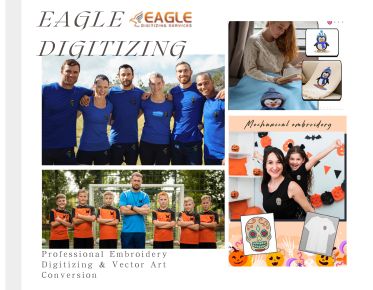From Sketch to Screen: Logo Embroidery Digitizing Timeframes
Logo digitizing has revolutionized the way businesses brand and present themselves in the modern era. From small startups to large corporations, the precise and detailed reproduction of logos on various mediums is essential for maintaining brand identity. This article delves into the intricate world of logo digitizing, offering a comprehensive overview of its processes, tools, and best practices.
What is Logo Digitizing?
Definition and Explanation
Logo digitizing is the process of converting a logo into a digital format that can be used by embroidery machines to stitch the design onto fabric. This involves transforming the logo into a series of commands that the machine can follow, ensuring that the final product is an accurate and detailed representation of the original design.
Importance of Logo Digitizing in Modern Business
In today's competitive market, brand recognition is crucial. Digitized logos enable businesses to consistently reproduce their branding on uniforms, promotional items, and merchandise. This consistency reinforces brand identity and ensures that customers can easily recognize and trust the brand across various platforms and products.
Evolution of Digitizing Technology
The journey of logo digitizing began with manual techniques that required painstaking effort and attention to detail. As technology advanced, computer-aided design (CAD) systems transformed the industry, allowing for greater precision and efficiency. Today, sophisticated software and high-tech embroidery machines work in tandem to produce impeccably digitized logos.
Key Milestones in Logo Digitizing
Significant milestones in the evolution of logo digitizing include the introduction of CAD software in the 1980s, which significantly reduced the time required for digitizing. The 1990s saw the advent of more user-friendly software and the integration of vector graphics, further enhancing the accuracy of digitized logos. In recent years, advancements in AI and machine learning have streamlined the digitizing process, making it more accessible to businesses of all sizes.
Understanding the Basics of Digitizing
Types of Logos Suitable for Digitizing
Vector Logos
Vector logos, composed of paths and points rather than pixels, are ideal for digitizing. Their scalability ensures that they can be resized without losing quality, making them perfect for detailed embroidery work.
Raster Logos
Raster logos, on the other hand, are made up of pixels and can lose clarity when resized. These logos require careful preparation before digitizing to ensure they maintain their integrity in the embroidery process.
Essential Tools and Software for Digitizing
Popular Digitizing Software
Some of the most popular software for logo digitizing include Wilcom, Brother PE-Design, and Hatch Embroidery. These programs offer a range of features, from basic digitizing tools to advanced options for customizing stitch patterns and textures.
Hardware Requirements
In addition to software, digitizing requires robust hardware. A high-resolution computer monitor, a powerful processor, and ample RAM are essential for handling the complex tasks involved in digitizing logos. Additionally, a reliable embroidery machine is crucial for testing and producing the final product.
The Digitizing Process: Step-by-Step
Preparing the Logo for Digitizing
Gathering Necessary Information
Before starting the digitizing process, gather all relevant information about the logo, including its dimensions, colors, and any specific requirements from the client. This guarantees that the end result fits their expectations.
Ensuring High-Quality Image
A high-quality image of the logo is crucial for accurate digitizing. Ensure that the image is clear, with distinct lines and no pixelation. This will facilitate a smoother digitizing process and a better final product.
Choosing the Right Digitizing Technique
Manual vs. Automatic Digitizing
Manual digitizing involves a skilled digitizer meticulously tracing the logo and setting each stitch type and pattern. Automatic digitizing, on the other hand, uses software algorithms to automate this process. While manual digitizing offers greater control and precision, automatic digitizing can save time and effort.
Pros and Cons of Each Method
Manual digitizing allows for customization and fine-tuning, making it ideal for complex logos. However, it is time-consuming and demands a high level of skill. Automatic digitizing is faster and more efficient but may lack the nuanced detail that manual digitizing can provide.
Setting Up the Digitizing Software
Installing and Configuring Software
Proper installation and configuration of digitizing software are critical for achieving optimal results. Follow the manufacturer's instructions carefully and ensure that all settings are tailored to the specific requirements of the logo and the embroidery machine.
Customizing Settings for Optimal Results
Customize the software settings to match the logo's specifications. This includes adjusting the stitch density, selecting the appropriate stitch types, and setting the correct thread colors. These adjustments ensure that the digitized logo is accurate and of high quality.
Creating the Initial Design
Tracing the Logo Outline
The first step in digitizing a logo is tracing its outline. This involves using the software's tools to create a path that the embroidery machine will follow. Precision is key here, as any mistakes will affect the final product.
Adding Details and Fine Lines
Once the outline is traced, add the finer details and lines of the logo. This step requires careful attention to ensure that all elements of the logo are accurately represented.
Selecting Stitch Types and Patterns
Common Stitch Types in Logo Digitizing
Several stitch types are commonly used in logo digitizing, including satin stitches for smooth edges, fill stitches for larger areas, and running stitches for fine details. Each type has its specific applications and contributes to the overall look of the logo.
Best Practices for Choosing Stitch Patterns
Choose stitch patterns that enhance the logo's appearance while ensuring durability. Consider the fabric type and the intended use of the embroidered logo when selecting stitch patterns.
Adjusting Colors and Textures
Matching Brand Colors Accurately
Accurate color matching is essential for maintaining brand consistency. Use the software's color-matching tools to ensure that the thread colors closely match the logo's original colors.
Creating Textures for a Professional Look
Textures add depth and dimension to the digitized logo. Experiment with different stitch patterns and techniques to create textures that enhance the logo's visual appeal.
Testing the Digitized Logo
Running Test Stitches
Before finishing the pattern, make some test stitches on a sample fabric. This helps identify any errors or issues that need to be corrected.
Identifying and Correcting Errors
Review the test stitches carefully and make any necessary adjustments to the digitized design. This ensures that the final product is free from errors and meets the client's expectations.
Finalizing the Digitized Logo
Reviewing and Saving the Design
Once the design is finalized, review it thoroughly to ensure that all elements are accurate and complete. Save the design in the appropriate file format for the embroidery machine.
Preparing Files for Different Embroidery Machines
Different embroidery machines may require different file formats. Prepare and save the digitized logo in all necessary formats to ensure compatibility with various machines.
How Long Does the Digitizing Process Take?
Factors Influencing the Time Required
Complexity of the Logo
The complexity of the logo significantly influences the time required for digitizing. Simple logos with fewer details can be digitized quickly, while intricate designs may take longer.
Skill Level of the Digitizer
The digitizer's skill level also affects the time required. Experienced digitizers can work more efficiently and produce high-quality results in less time.
Typical Timeframes for Logo Digitizing
Simple Logos
Simple logos typically take a few hours to digitize. These designs usually have fewer details and require less customization.
Complex Logos
Complex logos can take several hours or even days to digitize. These designs often have intricate details and multiple colors, and require careful attention to ensure accuracy.
Expediting the Digitizing Process
Tips for Faster Digitizing
To expedite the digitizing process, use templates and pre-sets whenever possible. Additionally, streamline your workflow by organizing your tools and resources efficiently.
Utilizing Templates and Pre-sets
Templates and pre-sets can significantly reduce the time required for digitizing. These tools provide a starting point that can be customized to fit the specific requirements of the logo.
Quality Control in Logo Digitizing
Ensuring Accuracy and Precision
Common Mistakes to Avoid
Avoid common mistakes such as incorrect stitch density, poor color matching, and ignoring fabric types. These errors can compromise the quality of the digitized logo.
Techniques for Quality Assurance
Implement quality assurance techniques such as regular reviews, test stitches, and client feedback to ensure that the final product meets the highest standards.
Receiving and Reviewing Feedback
Importance of Client Feedback
Client feedback is invaluable for improving the digitizing process. Encourage clients to provide detailed feedback and use it to make necessary adjustments.
Making Revisions Based on Feedback
Use client feedback to make revisions and improvements to the digitized logo. This ensures that the final product meets their expectations and enhances customer satisfaction.
Tips for Successful Logo Digitizing
Best Practices for New Digitizers
Learning Resources
New digitizers should take advantage of learning resources such as online tutorials, courses, and industry forums. These resources provide valuable knowledge and skills for successful digitizing.
Developing Skills Over Time
Developing digitizing skills takes time and practice. Continuously improving your techniques and staying updated with industry trends will enhance your capabilities and ensure high-quality results.
Common Pitfalls and How to Avoid Them
Overcomplicating Designs
One common pitfall is overcomplicating designs. Keep designs simple and focus on the essential elements to avoid unnecessary complications.
Ignoring Software Updates
Ignoring software updates can lead to compatibility issues and missed opportunities for new features. Regularly update your software to ensure optimal performance and access to the latest tools.
Logo digitizing is a complex but rewarding process that transforms logos into digital formats suitable for embroidery. By understanding the basics, choosing the right tools and techniques, and following best practices, digitizers can create high-quality, accurate representations of logos.
Successful logo embroidery digitizing requires attention to detail, continuous learning, and a commitment to quality. By following the guidelines outlined in this article, digitizers can enhance their skills and produce exceptional results that meet client expectations.



